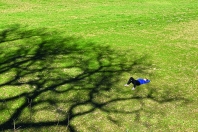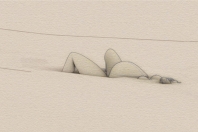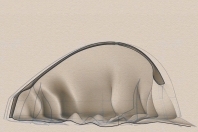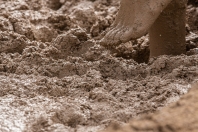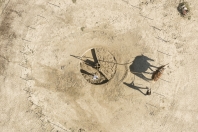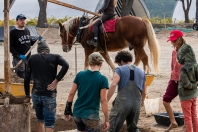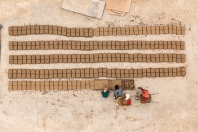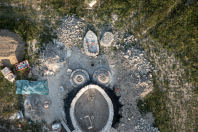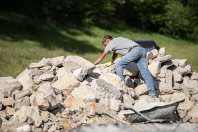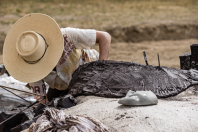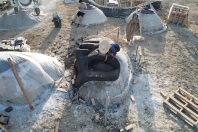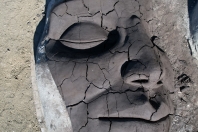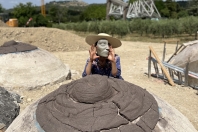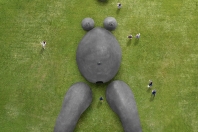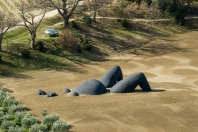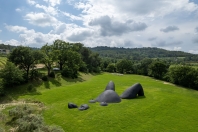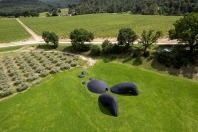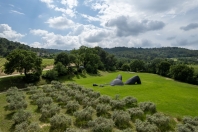Mater Earth
Prune Nourry invested the Château La Coste estate with Mater Earth, an immersive installation representing a pregnant woman lying on her back, with parts of her body emerging from the ground. Built of natural materials, the artwork is a testament to two recurring themes in Nourry’s oeuvre: the origin of human life and the myths of creation. The genesis of the project dates back to 2010, when Nourry asked an eight-month pregnant woman to sit for her. The model was positioned in an inflatable pool filled with milk so that only parts of her body would emerge from the still and opaque liquid: her belly, breasts, legs, elbows, and the extremities of her face. The artist created a life-size clay model based on a photograph, which then got molded to make a cast for a concrete sculpture. The idea of bringing a large-scale, immersive sculpture to life has always been in Nourry’s mind. The opportunity came up when Château La Coste commissioned her to produce a permanent new work for its outdoor art and architecture trail. The challenge, however, was to find the right spot for the sculpture on the grounds; it had to be seen from different angles and the curves of the work had to be in harmony with the rolling hills of the surrounding landscape.
Several specialists supported the project, including the architect Craig Dykers, from the practice Snøhetta, who regularly collaborates with the artist in New York and has a strong environmental awareness. Nourry also wanted to collaborate with a creative architect who had experience with small-scale building projects in raw clay. This is what led her to architect Wilfredo Carazas Aedo whom she invited to join the project. This French-Peruvian architect living in France has used raw clay natural materials in several constructions and restoration projects he worked on, such as the mosques in Timbuktu and Mopti. The coordination of this collective project was entrusted to Clotilde Berrou and Marc Kauffmann from the Marseillebased architectural practice bkCLUB, who oversaw everything from planning to execution, and made sure that everyone’s strengths and expertise were used to deliver this ground-breaking installation.
The use of natural and local materials is a recurring theme in Nourry’s work and has been at the core of this project since its inception. For many years, the artist has worked with amàco (Atelier Matières à Construire), a research center near Lyon specializing in building materials made especially with earth and natural resources. With their help, Nourry has created sculptures in earth concrete, less damaging for the environment. The artist has also used clay in various forms in the past, including terracotta for her monumental army of Terracotta Daughters (2012-2030) and raw clay for the large head she created after a traditional Mexican temazcal in 2014. Following several trips to the Mexican state of Chiapas with anthropologist Valentine Losseau in 2015 and 2016, Nourry made another giant head in adobe (a mixture of clay, sand and straw), which was the centerpiece of her Anima exhibition in New York.
Mater Earth is inspired by the structure of a Mexican temazcal. The temazcals are traditional sweat lodges made from raw clay, which originated with the pre-Hispanic indigenous peoples in Mesoamerica. Symbolizing the womb of Mother Earth, they are used in shamanic purifying rituals. For the sculpture at Château La Coste, visitors enter the woman’s belly before reaching a dark room – a space for contemplation. The only source of light, apart from the entrance, is a small window situated on the navel. The navel is made from solid glass filled with bubbles, flooding the space with a water-like experience when sunlight passes through. In more technical terms, the foundations are made of stone and lime mortar, the construction is made of fired bricks and raw earth bricks, i.e. 18,000 adobe bricks (raw earth) made by hand at Château La Coste with the help of a draft horse, the details of the nipples and face are cast in earth concrete, and the coating is in lime plaster and clay. With the assistance of Raj Patel and Léonard Roussel from agency Arup, the acoustics of the structure have also been carefully designed to enable visitors to focus on their heartbeats and give them the impression of floating in amniotic fluid. Together, the shape, sounds, light and use of earth materials aim to recreate the conditions of being in the womb – the origins of life. Like in a temazcal, the entrance is only 1.3 meters high, forcing visitors to bend down to get out. Emerging from the dark, they are blinded, for a short while, by the intense light, thereby experiencing a second birth, a “renaissance”.
The title of the installation, Mater Earth refers to the Latin root of “mother” and “motherhood”, as well as the notions of physical matter and “materials” such as clay. It is also a plea for a more responsible and sustainable world: “Earth matters”.


